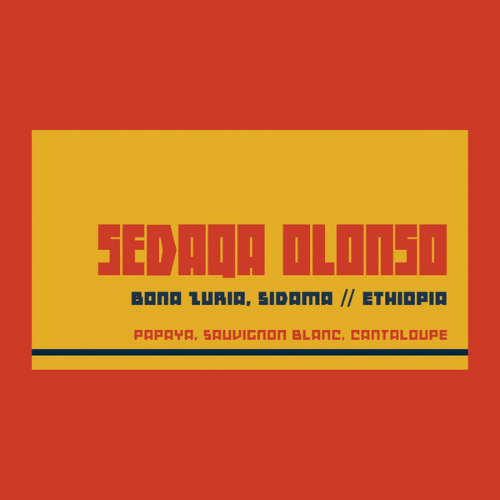Ethiopia – Sedaqa
19,22 $
Sweet and refreshing like a peach Arnold Palmer (lemonade/sweet-tea) with a crisp, white wine brightness and papaya finish.
Description
Technical Info
Producer: Small Holder Producers
Region: Bona Zuria, Sidama
Process: Washed
Elevation: 2,350 meters above sea level
Varietal: Zipa
The Sedaqa Olonso Washing Station
-words and photos by our sourcing and trade partner, Catalyst Trade
All sites have a claim to beauty, since they are in the countryside of Ethiopia. But the Sedaqa Olonso site stands out for its simple breathtaking beauty that unfurls, step by step, as you walk down its steep slope.
Sedaqa Alonso is a brand spanking new site. We visited in 2019 for the first time when the very first batches of coffee were drying on the range of raised beds and being scrubbed in the washing channels. There was an air of anticipation, and raw excitement about the entire site. Clear, lovely coffee trees dot the premises and offer sweet jasmine-like perfume. The tin storehouse was spotless; it even smelled new. A long, slanting driveway leads to the collection area where cherries from nearby smallholders are taken, weighed, and recorded. Then they are dumped into the large sun-dappled cement hopper and fed through the 3-disk Agard pulper into one of 9 fermentation tanks.
Once the parchment-covered beans have been fermented for 24-72 hours to remove the sticky mucilage, they are released into long, wide cement channels. Here is another point at which Sedaqa Alonso stuns: the water from the nearby Morodo river is so clear we might as well be in Idaho. Wooden rakes scrub the coffee, and then it is carried to the drying beds to be lovingly hand-turned, covered against the wind and rain, and eventually brought to the warehouse once its moisture content has reached the ideal window of 10-12%.
The site slopes aggressively toward the river, making it perfect to catch the cool uphill breeze and the benevolent sun. To facilitate drying, a high-quality neon green mesh covers the bamboo tables. Nearby nameless hills overlook the site; it is truly one of the most beautiful locations we’ve ever visited and by virtue of the sheer natural gifts of clean water an elevation can hardly fail to produce exceptional coffees.
The Producers:
400+ smallholder producers from the surrounding communities (kebeles) of
Olonso Qeka, Olonso Hore, Bahire Dalo and Sedaqa bring their ripe cherries to the Sedaqa Olonso washing station. As is true in most parts of Ethiopian, their farms are small, ranging from backyard “garden” coffee to an average of 2.75 hectares. Coffee is a cash crop, and though often a grower may produce only 2 or 3 bags per year, sale of their cherries enables them to improve their quality of life, send their children to school and purchase necessities. Having a washing station within the area means that they do not have to trek so far with their cherries, which besides being much more convenient and efficient, enables the cherries to reach the station while still at their peak of freshness.
Sidama ZONE:
Historically, the Sidama people have had many unique cultural attributes, including a voluntary farm-sharing program and a butter-sharing program (the only legal item women could own was butter, so they would trade, share, and compound butter to aid women in need). Subjugation by the Abyssinian rule of Menelik II in 1898 was succeeded by the Communist regime in the early 1980’s. Eventually, the Communist Derg Regime was overthrown by the coalition EPRDF, which was collectively ruled under the TPLF. In turn, that government was voted out in 2018. The Sidama people gained a big windfall for their culture when they held a record 98.5% YES vote in November of 2019 to break away from the SNNPR and establish Sidama as the 10th Regional State in Ethiopia. (Note: calling the people group “Sidamo” is a derogatory practice begun by the invading troops of Menelik, hence our use of the term “Sidama”)
Like many other areas of Ethiopia, subsistence farming is a way of life for the Sidama people, and in fact, their beautiful farms are notable for having more division between them (handmade fences of bamboo screens and other materials) and more evidence of year-round cultivation than is found in other areas. Enset, or false banana (called “Weese” in Sidama) is the main food crop, and it is used in many applications, from water storage in case of drought, to feeding animals, to serving as mats to support food preparation. Other products grown in Sidama include: wheat, oats, sugar cane, potatoes, and other vegetables. Every household plants food crops with trees, to the
benefit of both–that is, until eucalyptus began to be planted in the area and spread its poisonous influence. The short-term economic potential of the eucalyptus threatens the long-term forestation and ecology of the area.
Livestock is also a significant mover in the economy, though that began to shift with a massive population explosion limiting pastureland and the “tse-tse” fly epidemic of the early 20th century. Goats and oxen are still seen everywhere, dotting the rolling hills and lazily being herded across the roads which, though paved in places, still have a haphazard air as if nobody really knows why they exist.
The Sidama people comprise roughly 20% of the overall population of Ethiopia and thus have many administrative needs, which continue to be addressed. Coffee as a primary economic driver remains life-and-death important to the Sidama people, and to those of us who love the area and wish to continue supporting it, and them
Vendor Information
- No ratings found yet!



